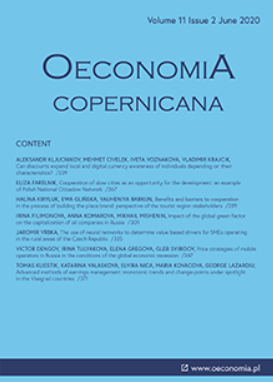Firm ownership and size versus innovation activities over the business cycle: near-zero inertia as a sign of the transition from the fifth to the sixth Kondratieff wave
Firm ownership and size versus innovation activities over the business cycle: near-zero inertia as a sign of the transition from the fifth to the sixth Kondratieff wave
Author(s): Aleksander Jakimowicz, Daniel RzeczkowskiSubject(s): Business Economy / Management, Economic history, Transformation Period (1990 - 2010), Present Times (2010 - today), Financial Markets, ICT Information and Communications Technologies
Published by: Instytut Badań Gospodarczych
Keywords: industrial processing enterprises; goals of innovative activity; business cycle; technological revolution; Kondratieff waves;
Summary/Abstract: Research background: The innovation activity of Polish industrial processing enterprises is examined in a broader time context than typical business cycle frames, which makes it possible to look at the investigated problems from the perspective of Kondratieff waves. Purpose of the article: The aim of the research is to describe the combined effect of mutual interactions between the ownership and size of Polish industrial processing enterprises on the goals of innovative activity and their degree of importance for the further development of the innovativeness of those firms. These relations are examined in various phases of the business cycle. Additionally, taking secular changes into account made it possible to lend credence to the claim that the global financial crisis is a typical phenomenon for the breakthrough period between two Kondratieff waves. Methods: A characteristic feature of the applied method is the focus on the combined effect of the enterprise type and ownership structure on firms’ innovation over three periods: prosperity 2004–2006, crisis 2008–2010 and recovery 2012–2014. As regards statistical techniques, the Pearson’s χ 2 independence test and correspondence analysis were applied. The results of the research are presented in a graphic form in three- and two-dimensional correspondence maps, which indicate the co-occurrence of (1) ownership sectors and enterprise types taken together, and (2) effects (goals) of the innovative activity of enterprises, together with the degree of their influence (importance) for further innovative activity. Mutual interactions between ownership sectors and enterprise types were visually analysed, indicating significant features of the triangles representing them. Findings & Value added: A significant combined effect of the ownership sectors and enterprise types on firms’ innovative activity was found. There was a certain type of dynamic equilibrium between those variables, which changes depending on the business cycle phase. In the global financial crisis of 2008–2010, a surprising phenomenon was found, consisting of the growth of innovative activity in most enterprises as compared to the period of prosperity in 2004–2006. The enterprises achieved the goals assumed, and the degree of their importance proved the significant influence on further innovative activity of those firms. Additionally, it was demonstrated that in the period of recovery (2012–2014) mutual interactions between ownership and size eliminated the relationship between those variables and the goals of innovative activity, and eco-innovations proved to be directly subordinated to traditional types of innovations, mainly product and process innovations. Changes occurring in the last of the examined periods are related to the near-zero inertia of the entire industrial processing section, which allows to interpret the global financial crisis as a typical phenomenon for a breakthrough marking the end of one Kondratieff wave and the beginning of the next. Moreover, 2015 is identified as the year of breakthrough, ending the Fifth and beginning the Sixth Kondratieff Wave, which was related to the transition from the information and telecommunications revolution to the biomedical-hydrogen revolution. The calculations presented in this paper are consistent with those forecasts.
Journal: Oeconomia Copernicana
- Issue Year: 10/2019
- Issue No: 4
- Page Range: 689-741
- Page Count: 53
- Language: English

